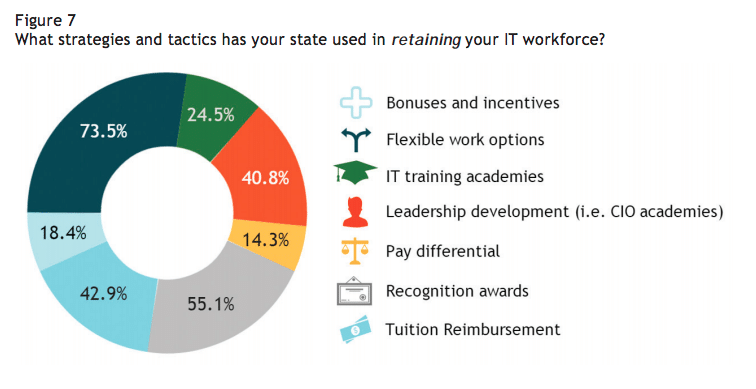State IT Workforce Recruitment and Retention
The National Association of State Chief Information Officers (NASCIO) State IT Workforce: Facing Reality with Innovation on the current landscape of the state Information Technology (IT) workforce.
This report highlights the current landscape of the state IT workforce and lists innovative techniques state IT agencies are using to recruit and retain both entry level and highly skilled personnel.
When states were asked if they were having difficulty recruiting new employees to fill vacant IT positions, 86% said yes. This is a dramatic increase from the 2011 report where 54.8% responded yes. The majority of states also reported that it is taking 60-90 days to fill entry level IT positions and 3-5 months for senior level IT positions.
Recruiting Government IT Talent
While the private sector has been aggressively recruiting IT candidates since the very beginning of the tech boom, state government agencies are now using the same methods, like building a talent pipeline to tap as IT positions open up to reduce the time necessary to fill critical positions. Looking at not only active IT candidates, but passive candidates as well.
When asked what attracts new IT employees to work for the state, benefits package (76%), job stability (72%) and pension/retirement plan (60%) were the top answers. These are typically the advantages that public sector jobs have over their private sector colleagues.
The predicted shortage in the state information technology (IT) workforce has been discussed and debated for over a decades. In fact, the overall tech unemployment rate remains well below the overall unemployment rate in the US, indicated a very tight market.
States have recovered from the 2008 recession, but tight budgets remain that limit the incentives that governments can offer to recruit and retain talented IT personnel.
 Baby Boomers = Retirement
Baby Boomers = Retirement
The report also focuses on the large number of state IT employees who are eligible for retirement or have been eligible, but postponed retirement due to the economic downturn. With the economy recovering, especially the recovery of the stock market/retirement funds, some states are experiencing record numbers of retirement.
For the first time in several years, “human resources/talent management” made NASCIO’s “Top Ten” list for 2015 of top priorities for state CIOs.
How will state government’s handling the shortage of IT personnel and new technology trends like cloud computing, software as a service (Saas), and cybersecurity? One way, outsourcing. While government unions frowned upon the practice, the struggle to hire government employees with the required skills is real and critical IT work only continues to grow as more and more government functions relay on technology infrastructure to deliver government services in an efficient manner.
Key highlights from “State IT Workforce: Facing Reality with Innovation” are:
- Nearly 92% of states say salary rates and pay grade structures present a challenge in attracting and retaining IT talent.
- 66% of respondents said the shortage of qualified candidates for state IT positions is hindering their state’s ability to achieve its strategic initiatives.
- 86% of states are having difficulty recruiting new employees to fill vacant IT positions.
- 46% of states report that it is taking 3-5 months to fill senior level IT positions.
- A shortage of qualified candidates for state IT positions is hindering 66% of states from achieving strategic IT initiatives.
- Security is the skill that presents the greatest challenge in attracting and retaining ITemployees.






